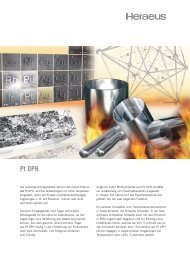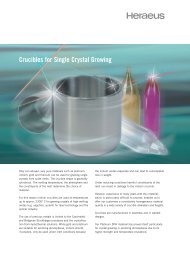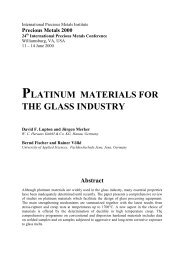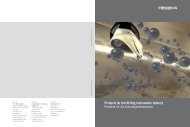Design and Manufacture of Bushings for Glass Fibre Production
Design and Manufacture of Bushings for Glass Fibre Production
Design and Manufacture of Bushings for Glass Fibre Production
Create successful ePaper yourself
Turn your PDF publications into a flip-book with our unique Google optimized e-Paper software.
<strong>Design</strong> <strong>and</strong> <strong>Manufacture</strong> <strong>of</strong> <strong>Bushings</strong> <strong>for</strong> <strong>Glass</strong> <strong>Fibre</strong> <strong>Production</strong><br />
Bushing design<br />
Many constraints <strong>and</strong> parameters must be considered in the design <strong>of</strong> a bushing.<br />
The basic geometrical aspects relate to the type <strong>of</strong> fibres to be produced <strong>and</strong> the<br />
choice <strong>of</strong> the melt system (indirect or direct). The thermal household is, however,<br />
also <strong>of</strong> fundamental importance. The aim <strong>of</strong> the fiberising process is to produce<br />
filaments with a uni<strong>for</strong>m diameter. This is only possible if the temperature <strong>of</strong> the glass<br />
as it leaves the bushing via all the tips is uni<strong>for</strong>m to within a few degrees. Marble<br />
bushings are subject to the additional constraint that a considerable amount <strong>of</strong><br />
electrical energy is required to melt the marbles on the upper per<strong>for</strong>ated sheet. The<br />
electrical design <strong>of</strong> a bushing can be considered as a number <strong>of</strong> resistors connected<br />
in parallel, the individual resistors being the walls, sheets <strong>and</strong> plates.<br />
The electrical connecting flanges are <strong>of</strong> decisive importance in achieving a<br />
homogeneous temperature distribution in the bushing. Typical designs <strong>of</strong> connecting<br />
flanges are shown in Figures 5a, 5b <strong>and</strong> 5c. The electrical energy is introduced by<br />
means <strong>of</strong> water-cooled copper clamps. The clamps also remove thermal energy <strong>and</strong><br />
can thus be used <strong>for</strong> cooling specific parts <strong>of</strong> the bushing .<br />
Figure 5: Three typical examples <strong>of</strong> electrical connecting flanges.<br />
The tip-plate is the essential feature <strong>of</strong> the bushing. The larger the tip-plate, the<br />
greater the danger that it will start to sag in operation. Sagging has two negative<br />
effects on the function <strong>of</strong> the bushing: the hydrostatic head <strong>of</strong> glass is no longer<br />
uni<strong>for</strong>m over the whole area <strong>of</strong> the tip-plate, <strong>and</strong> the tips are no longer parallel to<br />
each other. Double bottom-plates are supported additionally by a central support<br />
along the longitudinal axis, thus ensuring greater mechanical stability, Figure 6. The<br />
stability <strong>of</strong> single tip-plates can only be increased by numerous rein<strong>for</strong>cement ribs<br />
inside the bushing.<br />
– 7 –













